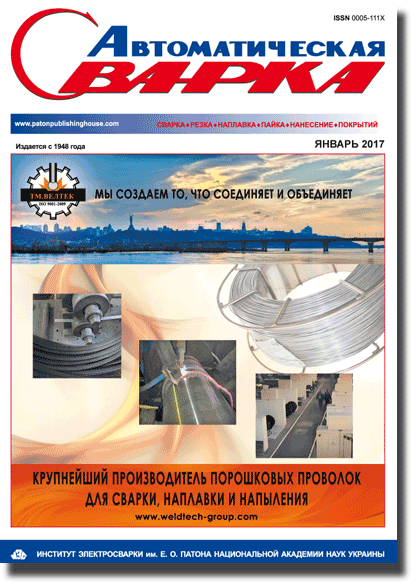| 2017 №01 (05) |
DOI of Article 10.15407/as2017.01.06 |
2017 №01 (07) |

Avtomaticheskaya Svarka (Automatic Welding), #1, 2017, pp. 43-48
Effect of flux-cored strip surfacing modes on geometric parameters of deposited beads
A.P. Zhudra, A.P. Voronchuk, V.O. Kochura and V.V. Fedosenko
E.O. Paton Electric Welding Institute, NASU 11 Kazimir Malevich Str., 03680, Kiev, Ukraine. E-mail: office@paton.kiev.ua
Abstract
The effect of parameters of flux-cored strip surfacing modes on geometric dimensions of deposited beads was investigated. The peculiarities of flux-cored strips melting were considered depending on a sheath type and chemical composition of the core. As the objects of investigations the widely applied flux-cored strips PL-AN 101 and PL-AN 179 were selected, which are manufactured on a base of the steel strip-sheath and also the strip PL-AN 111 based on a nickel sheath. The surfacing was carried out in the machine A-874N, equipped with the power source VDU 1201 and the attachment AD 167 within a wide range of modes. It was found that with increase in current from 600 to 1200 A for all the tested grades of flux-cored strips, the growth of a bead width, its height and penetration depth of base metal are characteristic. With increase in current the value of weld shape factor for all the considered types of flux-cored strips decreases. With increase in the arc voltage in the range of 24–38 V the bead width increases and the height is reduced against the growth in volume of base metal. The change in penetration depth and the weld shape factor are ambiguous and depend on the flux-cored strip type. 10 Ref., 1 Table, 4 Figures.
Keywords: flux-cored strip, surfacing modes, penetration depth, geometric parameters of bead, volume of base metal
Received: 16.02.17
Published: 02.12.16
References
- Danilchenko, B.V., Shimanovsky, V.P., Voronchuk, A.P. et al. (1989) Surfacing of wearing parts with self-shielded flux-cored strips. Svarka, 5, 38–41.
- Zhudra, A.P., Voronchuk, A.P. (2010) Wear-resistant flux-cored strip surfacing. Svarshchik, 6, 6–9.
- Zhudra A.P., Voronchuk, A.P. (2012) Cladding flux-cored strips (Review). The Paton Welding J., 1, 39–44.
- Belov, Yu.M. (1961) Influence of mode of automatic submerged arc surfacing with strip electrode on bead section. Proizvodstvo, 12, 6–8.
- Kravtsov, T.T. (1978) Electric arc strip electrode surfacing. Moscow: Mashinostroenie.
- Kazartsev, V.I., Kryazhov, V.M., Baranov, Yu.M. (1968) Penetration of base metal in electrode strip surfacing. Svarka, 3, 53–55.
- Nikolaenko, M.R., Kuznetsov, L.D., Kortelev, G.A. (1976) Transfer of electrode metal and homogeneity of properties of deposited layer in flux-cored strip electrode surfacing on forced modes. Proizvodstvo, 6, 33–34.
- Kuznetsov, L.D., Nikolaenko, M.R., Grinberg, N.A. (1980) Geometrical characteristics of bead in flux-cored strip submerged arc surfacing on forced modes. Svarka, 9, 58–59.
- Belousov, E.F., Zelenkin, Yu.A., Rykov, A.M. (1973) Automatic flux-cored strip surfacing of sealing surfaces of stop valves. Proizvodstvo, 3, 46–47.
- Paton, B.E. (1949) Process of electrode melting in automatic submerged arc welding. Trudy po Avtomat. Svarke pod Flyusom, 4, 22–38.
The cost of subscription/purchase order journals or individual articles
| Journal/Currency | Annual Set | 1 issue printed |
1 issue |
one article |
| TPWJ/USD | 384 $ | 32 $ | 26 $ | 13 $ |
| TPWJ/EUR | 348 € | 29 € | 24 € | 12 € |
| TPWJ/UAH | 7200 UAH | 600 UAH | 600 UAH | 280 UAH |
| AS/UAH | 1800 UAH | 300 UAH | 300 UAH | 150 UAH |
| AS/USD | 192 $ | 32 $ | 26 $ | 13 $ |
| AS/EUR | 180 € | 30 € | 25 € | 12 € |
| SEM/UAH | 1200 UAH | 300 UAH | 300 UAH | 150 UAH |
| SEM/USD | 128 $ | 32 $ | 26 $ | 13 $ |
| SEM/EUR | 120 € | 30 € | 25 € | 12 € |
| TDNK/UAH | 1200 UAH | 300 UAH | 300 UAH | 150 UAH |
| TDNK/USD | 128 $ | 32 $ | 26 $ | 13 $ |
| TDNK/EUR | 120 € | 30 € | 25 € | 15 € |
AS = «Automatic Welding» - 6 issues per year;
TPWJ = «PATON WELDING JOURNAL» - 12 issues per year;
SEM = «Electrometallurgy Today» - 4 issues per year;
TDNK = «Technical Diagnostics and Non-Destructive Testing» - 4 issues per year.





